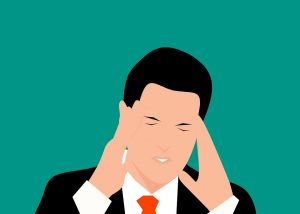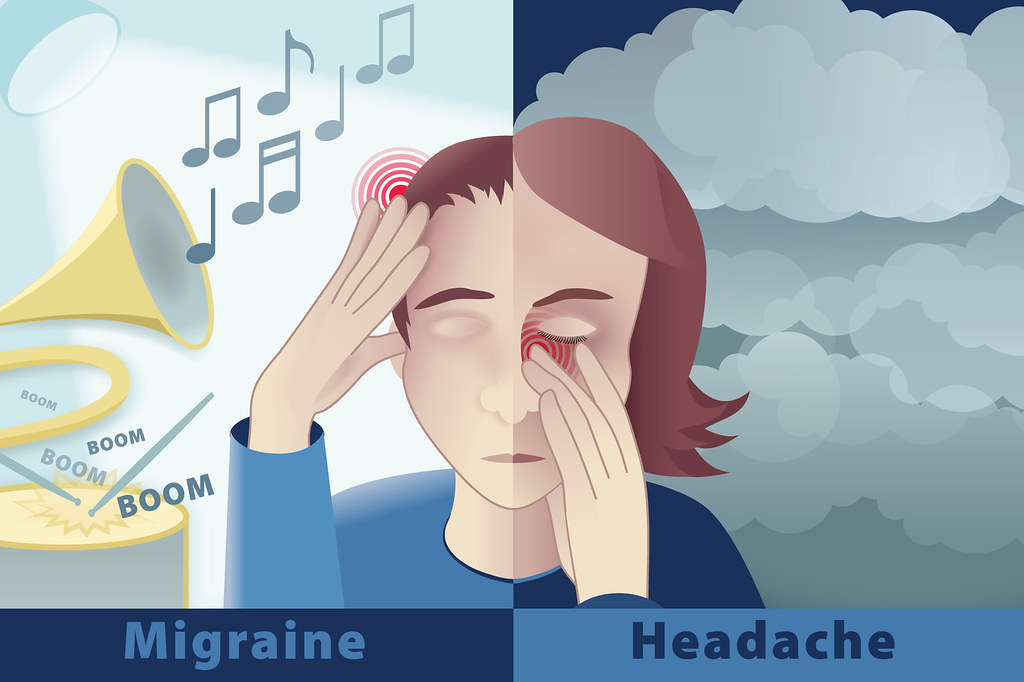If you find someone feeling uneasy and they tell you they have a headache disorder, it might be more diverse than just a disorder. Most of us either think of migraines or mild headaches when thinking about such a feeling. But it is important to understand these two are different and what they bring along. Here, we will discuss all about migraine vs. headache to understand how they are similar yet much different from each other.
Headaches are a nervous system condition that causes pain in the head. You are most likely to feel it in the forehead area. All of us have a headache at some point in lives, and even use it as a statement to describe how people make us feel!
According to WHO, more than 50% of adults across the world are prone to head pain. But can they differentiate between migraine vs. headache? Not everyone can! We bring to you easy ways to understand these two conditions and act upon them accordingly.
Table of Contents
What you need to know about migraine vs. headache
As said, both headaches and migraines are conditions caused by our nervous system. It gives us a sensation of pain in the head but can also get forwarded to the face and upper neck. The intensity and frequency keep changing with time and majorly depend on the condition.
Migraine is a painful headache and worse than mild pain in the forehead. These usually produce symptoms that get intense and can keep you away from doing regular chores. There are some types of migraines that don’t cause pain. But it can lead to severe damage and need medical attention. It is crucial for us to understand symptoms and act on it accordingly.
How do you determine a headache?
To be able to understand migraine vs. headache, you need to individually know them. Headaches are classified into two groups and they’re either primary or secondary. Primary ones refer to independent conditions and cause pain in the face, neck, and head. Primary headaches can be both tension headaches that we often get due to work pressure, and it can also be more intense like migraines. The secondary headache is usually a medical condition like stress, infection, or overuse of medication.

What are the types of primary headaches?
The two main types of primary headaches are detailed below:
1. The tension headache
Tension headaches are like a disorder that happens to more than 42% of adults across the globe. It feels like a band of intense pain that happens around the head. Most doctors classify these headaches as chronic or episodic conditions.
The episodic tension-type can happen for more than 10 days a month. But chronic conditions can lead to soreness in the scalp. Tension headaches can cause:
- Clenching of the jaw
- Depression
- Lack of sleep
- Hunger
- Anxiety
- Sleep apnea
- Stress
- Poor posture
- Arthritis
- Neck strain
2. Cluster headache
The name suggests that the pain is severe and also happens to one side of your head. Cluster headache usually targets the area behind your eye and they come in clusters. This means you can have multiple headaches at the same time and it can stay for several weeks. The headaches happen in cycles that keep recurring and also times when you don’t have a headache at all.
The National Institutes of Health states that cluster headaches can last for 6-12 weeks. They are more prominent in men than in women. The most symptoms of cluster headaches are:
- Extreme head pain on one side
- Water eyes or red eyes
- Pain behind the eyes
- Congestion
- Sweat
- Agitation or restlessness
- A quick change in heart rate
3. Hemicrania
This is yet another type of persistent headache that can differ in terms of severity. It affects the same side of your head. If you’re affected by this condition and can happen to you every day. People can experience a recurring problem and that’s why it needs medical attention. Symptoms of these headaches are:
- Vomiting
- Nausea
- Water eyes
- Sensitivity to sound or light
- Irritation or redness in eyes
- Sweat
- Congestion
- Eyelids swelling up
4. Secondary Headache
When you have a chronic medical condition or an illness, your nervous system can be affected by secondary headaches. The name suggests that it isn’t a direct reason why you should get a headache, but you have it anyway. Secondary headaches can happen due to:
- Brain tumor
- Sleep disorder
- Withdrawal from addiction or medication
- Strokes
- Head trauma
- Inflammation
- Leaking of spinal fluid
- Seizure
- Deformation on the head, spine or neck

What is migraine?
As you’re digging deep into migraine vs. headache, it is important to understand that migraine is a headache too! It is a form of primary headache that causes severe pain and shows different symptoms that makes you identify it.
People who have migraines might find themselves having a recurring problem and that’s what doctors call attacks or episodes. Headaches are symptoms of migraine pain and they can gradually become severe.
You might feel intense throbbing that lasts for a few hours to a number of days. Migraine headaches affect one side of your head, but there are people who have pain on both sides. You can have the condition in four distinct phases as well. But everyone doesn’t experience every phase.
What are the phases of migraines?
Check out the four distinct phases of migraine to understand it better. You might also be able to analyze if you’re facing any one of these:
1. Premonitory phase
Doctors call the premonitory phase as a preheadache phase. It might include nonpainful symptoms that happen for hours or for days before the headache turns up. The symptoms of the premonitory phase are:
- Mood swings
- Craving for good
- Neck stiffness
- Frequent yawns
- Diarrhea or constipation
- Sensitivity to sound, smell or light
2. Aura phase
The aura phase is when the sensory disturbances happen before you get a migraine attack. It can be diagnosed by a person’s speech, vision or touch.
Visual auras are:
- Flashing lights
- Blurred vision
- Zig-zag lines
- Blind spots that keep expanding
Sensory auras are:
- Numbness
- Tingling
Speech auras are:
- Jumbled speech
- Not understanding what other’s say
- Difficulty in writing
- Not being able to think clearly
3. Headache Phase
Migraines can be mild or severe. People who have a severe condition might have to get an immediate checkup backed up by medical treatment. Physical activity, exposure to light, smell, or sound can worsen the condition. People usually go through headache phases with migraine and that’s why this is another addition here.
4. Postdrome phase
You will come across this phase once your headache subsides. It might get you exhausted, unwell, or simply confused. These are symptoms of the postdrome phase. The signs can last anywhere from a few hours to days.
Different types of migraines
Migraine vs. headache cannot be differentiated as long as you don’t understand the types they are of. Check out the different types of migraines to know that better:
1. Migraine without the aura
Common migraines come without the aura and they cause intense throbbing and headache on one side of your head. These tend to last anywhere from 4 to 72 hours. The symptoms aren’t anywhere close to a migraine attack. However, people who tend to have such migraine conditions might have premonitory symptoms given above.
2. Migraine with aura
The National Institute of Neurological Disorders and Stroke stated that one out of every three people who report of migraine have an aura. It generally happens before a headache. However, every time they have a migraine pain it might not come with an aura.
3. Abdominal migraine
An article in 2018 stated that abdominal migraines tend to happen to kids between the age of three and 10. It leads to abdominal pain, vomiting, and nausea. Kids might have a mild headache but many times it isn’t a symptom.

4. Hemiplegic migraine
The rare migraine-type can cause temporary paralysis during or before a headache. You might also face symptoms like:
- Vertigo
- Vision problems
- Stabbing sensation
- Difficulty while speaking or eating
- Trouble while moving one side of your body
Migraine risk factors
There are some risk factors of migraine according to researchers. People who are at more risk of having migraine are:
- Women
- People with family heredity of migraine
- Sleep disorders
- People who have a mood disorder, anxiety, bipolar disorder, depression
Diagnosis
There are plenty of ways to detect migraines but finding the exact reason for headache is more challenging. Doctors tend to diagnose conditions like this by medical history and family history. You are more likely to go to a neurologist as they deal with disorders of the nervous system.

What triggers a headache?
People who have a migraine or any other type of headache will also get several symptoms that they can notice. These can vary from one person to another and they can be environment changes, specific food, and more. Check out some of the common triggers:
- Depression
- Stress
- Anxiety
- Lack of sleep
- Hormonal changes
- Hunger
- Alcoholism
Treatment
If you have a headache or migraine problems, it is smart to keep a journal handy. It will help you identify what triggers and also how you feel. There isn’t any definitive cure for both these conditions, but you can improve it by shifting to a better lifestyle.
People do turn to over-the-counter pills as they have like pain relievers. These generally include nonsteroidal anti-inflammatory medicines or acetaminophen. Ibuprofen or aspirins are common examples but should only be consumed after doctor’s recommendation.
A review in 2017 showed that several random placebo-controlled trials can prevent migraines, especially cluster migraines. The ideal dose might vary according to the condition, so it is good to follow what the doctor says about the treatment.
There are several home remedies that can ease your migraine condition. From drinking water regularly to adding magnesium in your diet, you can do a lot on that note. Avoiding late nights at work or watching web series instead of sleeping can also be a trigger. Avoid having alcohol and caffeine that disrupts your natural body. Thus, shifting to a better lifestyle can make your condition much better.
Prescription medication
Once you visit a doctor for your recurring migraine problem, he will prescribe medicines that you need to consume. But there are cases where the headache doesn’t stop with OTC medicines. In such cases you might be prescribed medicines likes:
- Anti-nausea medicine like beta-blockers
- Ergot alkaloids like ergotamine
- Triptans like almotriptan or naproxen
There are some medicines that prevent migraines from recurring. These include:
- Antiseizure medication
- Valproate
- Antidepressant
- Botox injection
There are also people who have OTC medicines after headaches, but they must also follow what doctors recommend. Overusing a medicine might cause people to develop conditions known as medication-overdose headaches.
Such medication overdose can happen when people consume too much of medication for treating a primary headache. Due to this, they develop a new kind of headache or have a worse condition of what pre-exists.
Ways to prevent migraine without medication
When you take measures to have a better lifestyle you refrain from taking medicines. It is not just about migraine vs. headache, but your life in general. Easy ways to have a better lifestyle and keep such conditions away from your life will include:
- Regularly exercising
- Avoid food that triggers migraine
- Following relaxing techniques like mindful meditation or breathing
- Following stress-management techniques
- Noting down your headache disorders in a journal to track patterns and prevent triggers
When to visit the doctor?
You need to visit a doctor if you experience headaches frequently and if they interfere with your daily activities. You need to also consider medical care if you have other symptoms like:
- Vomiting
- Nausea
- Eyesight problem
- Tingling in the neck, face, head, and limbs
- Difficulty in thinking
- Difficulty in speaking
- Not being able to move one side of your body
Final thoughts
Everybody has a headache at some point in their lives. Often this is caused by eyesight issues so if this is the case for you, get your eyes tested and you may be recommended total 1 multi focal lenses. But every kind of headache isn’t that bad, severe, or frequent. The disorder of headache can impact your ability to function and reduce the quality of life. It is important to diagnose the condition and find ways to cure it. When you start differentiating between migraines and headaches, you will be able to treat it correctly.





